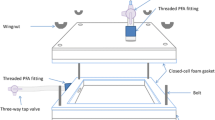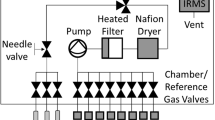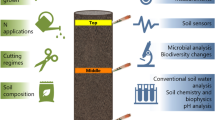Abstract
The present work describes an original method to follow rate of 14CO2 and total CO2 production from rhizosphere respiration after plant shoots had been pulse-labelled with 14CO2. We used a radioactivity detector equipped with a plastic cell for flow detection of beta radiation by solid scintillation counting. The radioactivity detector was coupled with an infrared gas analyser. The flow detection of 14CO2 was compared to trapping of 14CO2 in NaOH and counting by liquid scintillation. First, we demonstrated that NaOH (1 M) trapped 95% of the CO2 of a gaseous sample. Then, we determined that the counting efficiency of the radioactivity flow cell was 41% of the activity of gaseous samples as determined by trapping in NaOH (1 M) and by counting by static liquid scintillation. The sensitivity of the 14CO2- flow detection was 0.08 Bq mL−1 air and the precision was 2.9% of the activity measured compared to 0.9% for NaOH trapping method. We presented two applications which illustrate the relevance of 14CO2-flow detection to investigations using 14C to trace photoassimilates within the plant-soil system. First, we examined the kinetics of 14CO2 production when concentrated acid is added to NaH14CO3. This method is the most commonly used to label photoassimilates with 14C. Then, we monitored 14CO2 activity in rhizosphere respiration of 5-week old maize cultivated in soil and whose shoots had been pulse-labelled with 14CO2. We conclude that alkali traps should be used for a cumulative determination of 14CO2 because they are cheap and accurate. On the other hand, we demonstrated that the flow detection of 14CO2 had a finer temporal resolution and was consequently a relevant tool to study C dynamics in the rhizosphere at a short time scale.
Similar content being viewed by others
References
Barber D A and Martin J K 1976 The release of organic substances by cereal roots into soil. New Phytol. 76, 69–80.
Benoit P, Choné T and Barriuso E 1994 On-line measurement of total C and 14C of 14C-labelled organic matter. Soil Biol. Biochem. 26, 407–411.
Cheng W X, Coleman D C, Carroll C R and Hoffman C A 1993 In situ measurement of root respiration and soluble C concentration in the rhizosphere. Soil Biol. Biochem. 25, 1189–1196.
Cheng W X 1996 Measurement of rhizosphere respiration and organic matter decomposition using natural C-13. Plant Soil 183, 263–268.
Dalal R C 1979 Simple procedure for the determination of total carbon and its radioactivity in soils and plant materials. Analyst 104, 151–154.
Hodge A, Paterson E, Thornton B, Millard P and Killham K 1997 Effects of photon flux density on carbon partitioning and rhizosphere carbon flow of Lolium perenne. J. Exp. Bot. 315, 1797–1805.
Keith H, Oades J M and Martin J K 1986 Input of carbon to soil from wheat plants. Soil Biol. Biochem. 18, 445–449.
Meharg A A 1994 A critical review of labelling techniques used to quantify rhizosphere carbon flow. Plant Soil 166, 55–62.
Rouhier H, Billès G, El Kohen A, Mousseau M and Bottner P 1994 Effect of elevated CO2 on carbon and nitrogen distribution within a tree (Castanea sativa Mill.) - soil system. Plant Soil 162, 281–292.
Shepherd T and Davies H V 1993 Carbon loss from the roots of forage rape (Brassica napus L.) seedlings following pulse labelling with 14CO2. Ann. Bot. 72, 155–163.
Vanginkel J H, Gorissen A and van Veen J A 1997 Carbon and nitrogen allocation in Lolium perenne in response to elevated atmospheric CO2 with emphasis on soil carbon dynamics. Plant Soil 188, 299–308.
Warembourg F R 1975 Application de techniques radioisotopiques à l'étude de l'activité biologique dans la rhizosphère des plantes. Rev. Ecol. Biol. Sol 12, 261–272.
Warembourg F R and Billès G 1979 Estimating carbon transfers in the plant rhizosphere. In The soil-root interface. Eds. J L Harley and R S Russel. pp 183–196. Academic Press, London.
Warembourg F R and Kummerow J 1991 Photosynthesis/ translocation studies in terrestrial ecosystems. In Carbon isotope techniques, Chap. 2. Eds D C Coleman and B Fry. pp 11–37. Academic Press, Inc.
Whipps J M 1985 Effect of CO2 concentration on growth, carbon distribution and loss of carbon from the roots of maize. J. Exp. Bot. 36, 644–651.
Whipps J M 1990 Carbon economy. In The rhizosphere. Ed. J M Lynch. pp 59–97. John Wiley, Chichester.
Whipps J M and Lynch J M 1983 Substrate flow and utilization in the rhizosphere of cereals. New Phytol. 95, 605–623.
Rights and permissions
About this article
Cite this article
Nguyen, C., Todorovic, C., Robin, C. et al. Continuous monitoring of rhizosphere respiration after labelling of plant shoots with 14CO2 . Plant and Soil 212, 189–199 (1999). https://doi.org/10.1023/A:1004681528074
Issue Date:
DOI: https://doi.org/10.1023/A:1004681528074




